Summary
In car crashes, serious injuries are more likely to occur in side-impact crashes since passengers can be extremely close to the impact site with no protective region of the car to crumple and absorb the impact. Therefore, it is imperative that we find as many improvements to car design as possible that could help prevent or lessen the impact of side-impact collisions. In this activity, students brainstorm ideas to best reduce side-impact collision, and then build and test their prototypes. Students then have the opportunity to improve their design before final testing. After final testing each team reports on the ideas and successes of their design.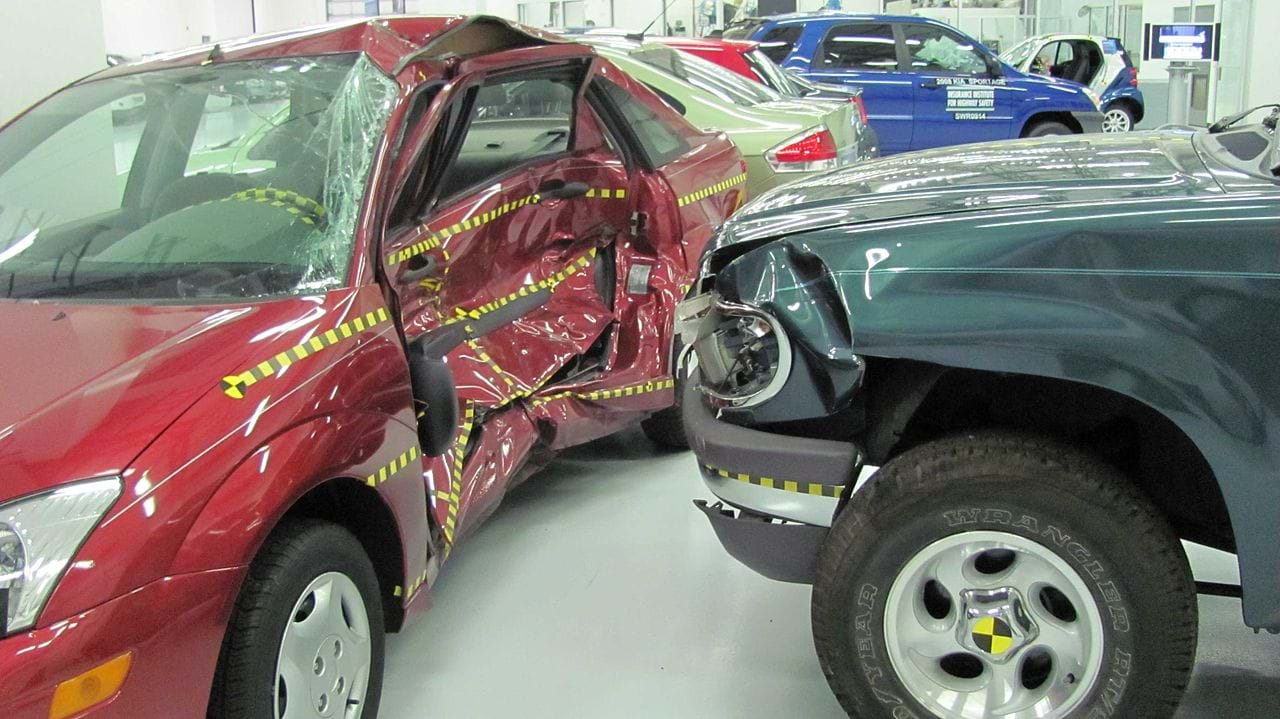
Engineering Connection
Engineers design the cars we drive and ride in every day. They are responsible for the many components of the car; from its shape and how it reacts to the airflow around the vehicle, to the engine and how to get the best performance. Engineers even help design electronics in the vehicle. One specific area of engineering for vehicles is crash test safety. Engineers work hard to make vehicles as safe as possible for the people inside, especially during crashes. Sometimes engineers purposefully crash the cars to see how they perform in a crash scenario. They use this data to make the cars even safer.
Learning Objectives
After this activity, students should be able to:
- Apply the physics of forces to safety during car crashes.
- Describe how force AND time affect the impulse (or impact) of collisions.
- Design a car safety feature specific for side-impact crashes and test the feasibility of their idea.
Educational Standards
Each TeachEngineering lesson or activity is correlated to one or more K-12 science,
technology, engineering or math (STEM) educational standards.
All 100,000+ K-12 STEM standards covered in TeachEngineering are collected, maintained and packaged by the Achievement Standards Network (ASN),
a project of D2L (www.achievementstandards.org).
In the ASN, standards are hierarchically structured: first by source; e.g., by state; within source by type; e.g., science or mathematics;
within type by subtype, then by grade, etc.
Each TeachEngineering lesson or activity is correlated to one or more K-12 science, technology, engineering or math (STEM) educational standards.
All 100,000+ K-12 STEM standards covered in TeachEngineering are collected, maintained and packaged by the Achievement Standards Network (ASN), a project of D2L (www.achievementstandards.org).
In the ASN, standards are hierarchically structured: first by source; e.g., by state; within source by type; e.g., science or mathematics; within type by subtype, then by grade, etc.
NGSS: Next Generation Science Standards - Science
| NGSS Performance Expectation | ||
|---|---|---|
|
HS-PS2-3. Apply scientific and engineering ideas to design, evaluate, and refine a device that minimizes the force on a macroscopic object during a collision. (Grades 9 - 12) Do you agree with this alignment? |
||
| Click to view other curriculum aligned to this Performance Expectation | ||
| This activity focuses on the following Three Dimensional Learning aspects of NGSS: | ||
| Science & Engineering Practices | Disciplinary Core Ideas | Crosscutting Concepts |
| Apply scientific ideas to solve a design problem, taking into account possible unanticipated effects. Alignment agreement: | If a system interacts with objects outside itself, the total momentum of the system can change; however, any such change is balanced by changes in the momentum of objects outside the system. Alignment agreement: Attraction and repulsion between electric charges at the atomic scale explain the structure, properties, and transformations of matter, as well as the contact forces between material objects.Alignment agreement: Criteria and constraints also include satisfying any requirements set by society, such as taking issues of risk mitigation into account, and they should be quantified to the extent possible and stated in such a way that one can tell if a given design meets them.Alignment agreement: Criteria may need to be broken down into simpler ones that can be approached systematically, and decisions about the priority of certain criteria over others (trade-offs) may be needed.Alignment agreement: | Systems can be designed to cause a desired effect. Alignment agreement: |
| NGSS Performance Expectation | ||
|---|---|---|
|
MS-ETS1-1. Define the criteria and constraints of a design problem with sufficient precision to ensure a successful solution, taking into account relevant scientific principles and potential impacts on people and the natural environment that may limit possible solutions. (Grades 6 - 8) Do you agree with this alignment? |
||
| Click to view other curriculum aligned to this Performance Expectation | ||
| This activity focuses on the following Three Dimensional Learning aspects of NGSS: | ||
| Science & Engineering Practices | Disciplinary Core Ideas | Crosscutting Concepts |
| Define a design problem that can be solved through the development of an object, tool, process or system and includes multiple criteria and constraints, including scientific knowledge that may limit possible solutions. Alignment agreement: | The more precisely a design task's criteria and constraints can be defined, the more likely it is that the designed solution will be successful. Specification of constraints includes consideration of scientific principles and other relevant knowledge that is likely to limit possible solutions. Alignment agreement: | All human activity draws on natural resources and has both short and long-term consequences, positive as well as negative, for the health of people and the natural environment. Alignment agreement: The uses of technologies and any limitations on their use are driven by individual or societal needs, desires, and values; by the findings of scientific research; and by differences in such factors as climate, natural resources, and economic conditions.Alignment agreement: |
| NGSS Performance Expectation | ||
|---|---|---|
|
MS-ETS1-2. Evaluate competing design solutions using a systematic process to determine how well they meet the criteria and constraints of the problem. (Grades 6 - 8) Do you agree with this alignment? |
||
| Click to view other curriculum aligned to this Performance Expectation | ||
| This activity focuses on the following Three Dimensional Learning aspects of NGSS: | ||
| Science & Engineering Practices | Disciplinary Core Ideas | Crosscutting Concepts |
| Evaluate competing design solutions based on jointly developed and agreed-upon design criteria. Alignment agreement: | There are systematic processes for evaluating solutions with respect to how well they meet the criteria and constraints of a problem. Alignment agreement: | Models can be used to represent systems and their interactions. Alignment agreement: |
International Technology and Engineering Educators Association - Technology
-
Students will develop an understanding of the attributes of design.
(Grades
K -
12)
More Details
Do you agree with this alignment?
-
Students will develop an understanding of engineering design.
(Grades
K -
12)
More Details
Do you agree with this alignment?
-
Students will develop abilities to apply the design process.
(Grades
K -
12)
More Details
Do you agree with this alignment?
-
Students will develop an understanding of the relationships among technologies and the connections between technology and other fields of study.
(Grades
K -
12)
More Details
Do you agree with this alignment?
State Standards
Texas - Science
-
Force, motion, and energy. The student knows that there is a relationship between force, motion, and energy. The student is expected to:
(Grade
8)
More Details
Do you agree with this alignment?
Materials List
Teacher demo:
- Sheet of aluminum foil
- Small amount of clay
Each group needs:
- 1-2 aluminum cans (have a consistent size of aluminum can for each group).
- 4 sheets of paper
- cardboard folder
- foam cup
- 1 m (~3 ft) of masking tape (total of 3-4 rolls per class)
For the class to share:
- Crash apparatus (such as a heavy ball or weighted toy car rolling down ramp). The crash apparatus might be a ramp set up for a heavy ball or car to roll down into the “parked car” (aluminum can) set against a wall, for example. Most importantly, the crash apparatus needs to be set up so each “crash” is able to be repeated with consistent speeds and forces.
Worksheets and Attachments
Visit [www.teachengineering.org/activities/view/rice2-2545-car-design-side-impact-crash-safety-feature] to print or download.Pre-Req Knowledge
Basic understanding of Algebra, ability to understand meaning of variables in equations, basic understanding of forces
Introduction/Motivation
Start this activity with the following PowerPoint Presentation.
(Slide 1) Today we are going to explore the safety engineering for car crashes, specifically how side-impact crashes can be more dangerous for car passengers than front-end crashes.
(Slide 2) To better understand the problem with side-impact crashes, let’s watch and compare two video clips: one of a front-end crash and one of a side-impact crash. While we watch these clips, ask yourself, “Which crash is more vulnerable and why?” [Show the following clip of a front-end crash, focusing on time 00:20-00:50: https://www.youtube.com/watch?v=vCXaR3_r164. Then show the following clip of a side-impact crash: https://www.youtube.com/watch?v=AzOCzESlLlY] From these clips we can see that the side-impact crash does not have the same amount of cushion as a front-end crash. The front-end of cars are designed to crumple and absorb the energy of the crash. However, in a side-impact crash, the body of the driver or passenger is right next to the impacting vehicle plus flying glass, even with the presence of air bags.
(Slide 3) In fact, side-impact auto accidents account for about 25% of the fatalities in passenger vehicle crashes. alone. Serious injuries are also more likely to occur in side-impact crashes since passengers can be extremely close to the impact site and there is little to no protective region on the sides of the car to crumple and absorb the impact. For these reasons, it is imperative that we find as many improvements to car design as possible that could help prevent or lessen the impact of side-impact collisions.
(Slide 4) Today we will use the engineering design process to design, build, and test prototypes of vehicle safety features that can provide information on how to make vehicles safer in crashes.
(Slide 5) First the first step, let’s reiterate what the problem is that we are trying to solve: How can we design a car to make side-impact crashes safer?) Next we want to identify the constraints of the problem. (Potential answers: Cost, type of materials, amount of materials. Also, a car door is typically thin and door must be able to open to allow entry into the car.)
(Slide 6) Next we need to research the topic. What information do we need to know in order to find a solution? (Listen for potential answers.)
(Slide 7) What do we know so far about how to protect people in car accidents? (Listen for potential answers.) What types of car materials protect passengers more? (Let students offer answers.)
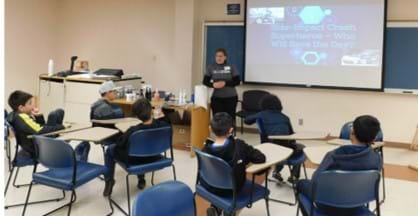
(Slide 8) We are going to investigate the role of soft, flexible materials vs. strong, rigid materials in a crash impact by doing a quick activity. Let’s have everyone stand up and jump as high as you can. How did you land on the floor? Were your knees and ankles stiff and rigid or flexible and bent? Try jumping high again but this time try a gentle, very tiny jump with your legs stiff. What do you notice about the impact of hitting the floor?
Now if a car was made completely of soft metal, it would be very dangerous for people to be inside of metal that crumples too easily. [Provide a quick demo of a piece of aluminum foil around a small, clay person and show how crumpling squashes the occupant inside.] The fact is, that a car needs to have soft flexible material between the passenger and the impacting car and the car needs a safety box made of hard, rigid material around the occupants to keep people safe in a crash.
(Slide 9) To illustrate good and poor structural car designs, let’s watch this short video. [Show the following video clip from 16 min. to 20:30 min.: https://www.youtube.com/watch?v=yUpiV2I_IRI]
(Slide 10) Another crash concept we need to know about is that soft, flexible materials increase the time it takes to stop, which lessens the force felt by the occupant and is the only difference between a regular car stopping with brakes and a faster, harder, crashing stop. Let’s look at the math behind decreasing the damage caused by stopping car momentum in a crash. How do we decrease the force (F)? [Show the following clip of the last video from the 4:20 to 9:30 mark. https://www.youtube.com/watch?v=yUpiV2I_IRI]
(Slide 11) [Write the formula Ft=mv on the board.] The formula, Ft=mv, says that the impulse caused by stopping the momentum (mass times velocity) of a car involves the force felt in a crash (F) over a certain amount of time (t). To achieve a smaller amount of force felt, the time must increase to compensate for it. So overall, the longer it takes for a material to crumple, the more time it takes for the crashing car to come to a stop and the more the force is reduced…so you don’t want the material to be too soft and flexible or it will crumple too fast!
(Slide 12) You engineering challenge today is to design a car that can make side-impact crashes a little safer using the engineering design process.
(Slide 13) In your groups, you will first brainstorm as many design ideas as you can.
(Slide 14) As a group, you will then select the most promising solution.
(Slide 15) You are then going to make a prototype of your design.
(Slide 16) When your prototype is complete, you are going to test your design, asking yourselves: How did it go? What were the problems?
(Slide 17) You will then have time to redesign your idea/prototype and retest it.
(Slide 18) Finally you will explain what you did, what happened, and what you would like to try next.
Let’s get started!
Procedure
Background
Engineers design cars to be both useful and safe for the occupants. Safety, however, has several aspects to it. Students might assume that cars need to be super strong and resistant to bending in order to be safe. However, although occupants need a super strong “safety cage” around them, there is a fundamental physics principal for students to explore that reveals that the impulse of a crash consists of force and time. The way to increase time during a crash, and lessen force, is to have a portion of the car that purposely bends and crumples (in the proper amount) to lengthen time and “cushion” the crash. Both of these engineering concepts (strong and flexible materials) must be incorporated into cars to make them safer and decrease occupant injuries.
Before the Activity
- Gather materials and make copies of the Student Worksheet.
- Decide on how limits for each group’s resources (i.e., 4 sheets of paper, 1 cardboard folder, 3 ft. of masking tape, 1 foam cup)
- Set up the PowerPoint Presentation.
With the Students
- Divide the class into groups of 3-4 students and have each team choose a group leader.
- Have a group leader get the materials for each group.
- Brainstorm (5-10 min): Have students brainstorm as many ideas as they can to protect their car, which in this case will be represented by an aluminum can. Have them write down at least 4-5 specific construction method ideas that will pad and cushion the side of the can, without being too bulky. Note: The teacher can choose if there are any other constraints or restrictions, such as limiting the amount of tape, materials, or thickness of padding allowed at one time.
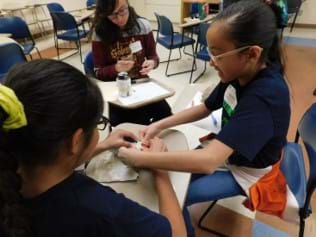
- Select and construct the most promising solution: Have students discuss the pros and cons of each brainstormed idea. Have them focus on which idea seems to have the most potential for following the guidelines but still protecting the car. Have them vote on which idea to test first.
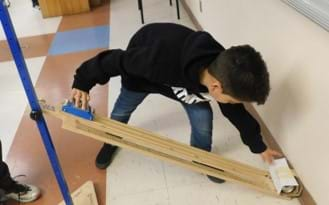
- Build! Give students time to construct their design with the materials chosen.
- Test and Evaluate the Prototype: Have students test their aluminum can in a crash apparatus to see if it is protected. Note: The crash apparatus might be a ramp set up for a heavy ball or car to roll down into the “parked car” (aluminum can) set against a wall, for example. Provide time for students to evaluate how well their can survived the crash without being dented.
- Redesign. Have students make improvements to their design as needed. Set up a time-limit and let them know how long is left before the finalized model is due to compete against other teams to see which car survives with the least amount of denting possible.
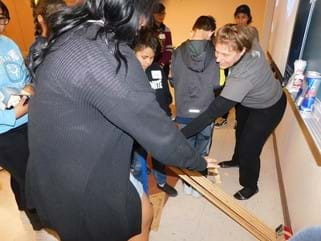
- Challenge! Now it’s time to compete against the other groups to see who has the best design to protect their car and end up with the least number of dents on their aluminum can. Each group tests their design in the crash apparatus. After each group tests, have their aluminum cans lined up on the table for comparison. Ask students to vote on which cans are the least dented.
- Reflection. Have students take time to reflect on why certain designs might have been more successful and ask students to record their thoughts on pros and cons on certain elements in theirs and other designs.
- Report. Ask 2-3 groups to report out their thinking behind their design and what they intended to happen, reflecting on how well the results followed what they thought was going to happen and any changes they had made after their first trials.
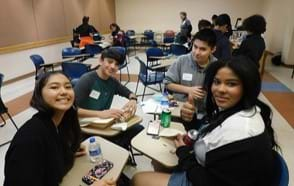
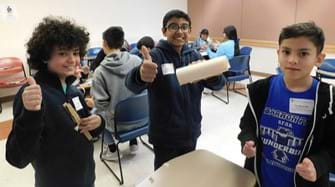
Vocabulary/Definitions
force: Any push or pull that changes the motion of an object.
front-impact crash: Crash where a car is hit head-on by either another car or an object such as a telephone pole.
impact: High force or shock applied over a short time period when two or more bodies collide.
Impulse: The change in momentum caused by a force applied over a time interval.
momentum: The product of the mass and velocity of an object that tends to oppose changes to its motion.
side-impact crash: Crash where a car is hit on the side by either another car or an object such as a telephone pole.
Assessment
Pre-Activity Assessment
Follow the question prompts in the PowerPoint Presentation, including:
Ask if students have ever seen a car crash or can name several types of crashes.
Ask if students have ever heard of someone getting injured in a car crash.
Activity Embedded (Formative) Assessment
As groups share out the results from their safety features in the front of the class, try to make sure the discussion includes elements from their knowledge of impulse, force, time, and flexible vs stiff materials. Assess student learning with the following rubric:
| 4 | 3 | 2 | 1 |
| Student has an excellent explanation for why their design worked (or didn’t work) and has a very strong connection to the concepts of impulse, force, time, of flexible vs. stiff materials. | Student has a good explanation for why their design worked (or didn’t work) and has a well-defined connection to the concepts of impulse, force, time, of flexible vs. stiff materials. | Student has some explanation for why their design worked (or didn’t work) and has a weak connection to the concepts of impulse, force, time, of flexible vs. stiff materials. | Student has no explanation for why their design worked (or didn’t work) and has no connection to the concepts of impulse, force, time, of flexible vs. stiff materials. |
Post-Activity (Summative) Assessment
Worksheet: Use the Student Worksheet as the formative assessment to identify student success in following the steps of the engineering design process.
Investigating Questions
- What are the different parts of a car that contribute to the safety of a car during collisions?
- What are the features to be considered for a car side-impact safety feature?
Activity Scaling
- For lower grades and younger students, use define impulse as the “amount of force you actually feel” and focus more on the design and testing process of the safety feature, but not as much on the whole engineering design process.
- For older or more advanced students, set cost limits on materials available and give them budgets for them to follow.
Additional Multimedia Support
Video: Impulse and Momentum - Professor Dave Explains
https://www.youtube.com/watch?v=E13h1E_Pc00
Video: Solving for Force and Impulse – Khan Academy
Impulse & Momentum Summary – The Physics Hypertextbook
https://physics.info/momentum/summary.shtml
Momentum and Impulse Connection - The Physics Classroom
Subscribe
Get the inside scoop on all things TeachEngineering such as new site features, curriculum updates, video releases, and more by signing up for our newsletter!Copyright
© 2021 by Regents of the University of Colorado; original © 2020 Rice UniversityContributors
Sheri ArevaloSupporting Program
RICE University RET program (Research Experience for Teachers), University of TX-El Paso (UTEP), Nanotechnology Enabled Water Treatment Systems (NEWT)Acknowledgements
This curriculum was based upon work supported by the National Science Foundation under Rice University Engineering Research Center for Nanotechnology Enabled Water Treatment Systems (NEWT) RET grant no.1449500. Any opinions, findings, and conclusions or recommendations expressed in this material are those of the authors and do not necessarily reflect the views of the National Science Foundation.
NEWT program at UTEP, special thanks to Dr. Jorge Gardea-Torresde, Reagan Turley and Christina Crawford
Last modified: January 10, 2022







User Comments & Tips